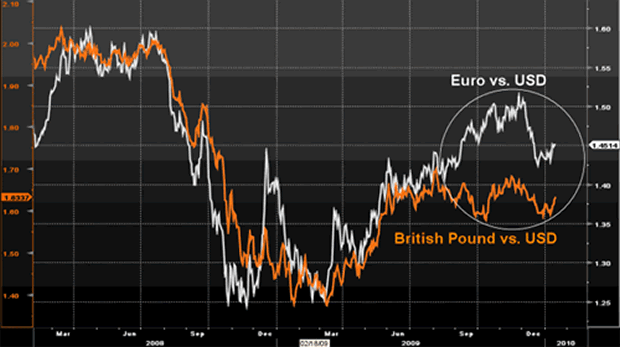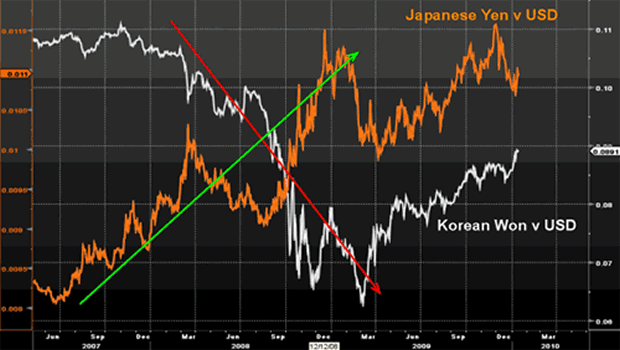Reduce Your Risk in Currency Trading By Using Twin Pairs
Currencies / Forex Trading Jan 16, 2010 - 03:06 PM GMTBy: Bryan_Rich
 Pair trading is a popular stock-trading strategy. It gives you the opportunity to capture a dislocation between two stocks by taking a long position in one stock and simultaneously taking a short position in another — in equal dollar amounts.
Pair trading is a popular stock-trading strategy. It gives you the opportunity to capture a dislocation between two stocks by taking a long position in one stock and simultaneously taking a short position in another — in equal dollar amounts.
In identifying a good pair trade, you’d look for two stocks that share the same industry, the same sector or simply have a strong historical statistical correlation. Yet for the time being, the share price of one may have gone up (the one you go short), while the other company’s stock (the one you go long) went down.
Your trade is successful when prices come back to the historical norms of the trading relationship.
Now … I generally talk about currencies in this column. So what does pair trading have to do with currencies?
A lot, as you’ll see in a moment …
First, here’s a bit more background: If you’re trading two like-companies (long one, short another) with similar economic exposures and similar historical price characteristics, you’re hedged to an extent regardless of where the market goes. And your trade should make money if you are right about the divergence in value among the two securities.
That’s one of the key benefits of pair trading strategies. It’s the ability to strip out the influence of the general market or sector performance on your trade. After all, those influences should have a similar impact on both the long and short component of the pair trade. That’s why pair trading is sometimes called “market neutral.”
And minimizing external risks in a currency trade can be just as easy …
 |
| Pair trading can help minimize losses. |
You see, currency investing is a pair trade too, since currency values aren’t determined in isolation. Evaluating the value of a currency is only meaningful when it’s compared to the value of another currency. It’s a constant exercise in relativity.
As we know, currencies can be highly sensitive to the broad economic climate. And that’s never been more apparent than today given the looming time bombs that threaten to derail the paths of financial markets, such as:
- Unfolding sovereign debt problems,
- Rising protectionism,
- Unprecedented global policy actions and the unintended consequences,
- And new burgeoning asset bubbles.
But if you don’t want to take the macro view on how the global economy will play out this year, you can minimize such general market risk by looking to intraregional currency crosses.
I’m talking about a long/short pair trade between two regional currencies. For these trades, the correlations tend to be very tight during shock events — which can minimize potential losses. Meanwhile you can still be positioned for a nice winner.
Let’s take a look at a couple examples of intraregional-currency plays that offer nice profit opportunities, while reducing the risks of a shock to the global economy.
Intraregional-Currency Play #1: Intra-Europe
The paths of the euro and the British pound have diverged in recent months due to the underperformance of the UK economy relative to that of the Eurozone. But despite the troubled economic position of the UK, the euro could be vulnerable to a sharper decline.
The culprit: Sovereign debt problems …
Greece has been downgraded by all three ratings agencies on concerns about their ability to service government debt. Now Portugal, Spain, Italy and Ireland are all under the microscope for similar reasons.

Source: Bloomberg
You can see in the chart above the recent divergence in the currencies of the two key European Union member economies.
I think we’ll see both move lower. But the euro will likely fall faster as the issues with Greece and other weak spots in the Eurozone continue to unfold. Therefore, I’m looking for the euro to weaken against the pound, bringing the spread, circled above in the chart, back together.
Next, let’s look at Asia …
Intraregional-Currency Play #2: Intra-Asia
Even through the depths of the global financial crisis, the Japanese yen was strengthening. In fact, the Japanese yen has been the best performing currency in the past 2½ years. Meanwhile other Asian currencies were crushed during the height of uncertainty.
Why did the yen outperform so dramatically?
When the financial crisis hit, a divergence developed between the yen and other Asian currencies …
This was driven by the forced unwinding of the yen carry trade. In other words, the huge interest rate gap between Japan and the rest of the world that drove investors to borrow massive amounts of yen for virtually free, exchanging it for higher yielding currencies around the world … went bust! Consequently, hordes of investors were forced back into yen.

Source: Bloomberg
More recently, the Asian currencies, including the yen, have been moving in the same direction. But the sour economic conditions in Japan and attempts to fight record deflation with more stimulus is beginning to weigh on the yen.
Meanwhile, South Korea’s economy has fared far better on a relative basis. This makes a convergence between the yen and the won likely, and offers the potential for a profitable pair trade.
In sum: Even in times when the broad economic environment is playing such a dominant role in determining the path of the general currency markets, there are still opportunities to capture gains without taking undue risk.
Regards,
Bryan
Weiss and Weiss Research analysts offering the latest investing news and financial insights for the stock market, including tips and advice on investing in gold, energy and oil. Dr. Weiss is a leader in the fields of investing, interest rates, financial safety and economic forecasting. To view archives or subscribe, visit http://www.moneyandmarkets.com
© 2005-2022 http://www.MarketOracle.co.uk - The Market Oracle is a FREE Daily Financial Markets Analysis & Forecasting online publication.



